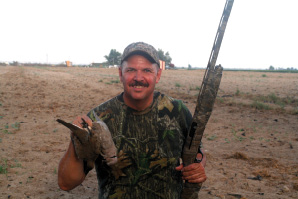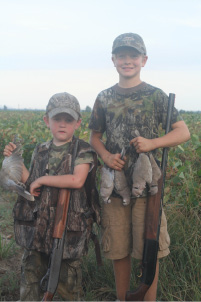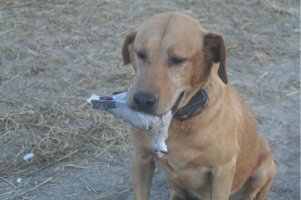
By Kenneth L. Kieser
Northeast News
September 1, 2011
I recently wrote this letter to Remington Arms:
Dear Remington,
I sent back the 870 Wingmaster I bought yesterday and enclosed a letter demanding a full refund and perhaps an apology. I realize that your 870 is one of the toughest and most dependable shotguns ever made, normally. Sadly, I am sure you sold me a defective model.
Let me explain: Last week I took my new shotgun out of the box, oiled it and went dove hunting. Five boxes of shells and no doves later, I stomped out of the field and to the nearest gun range. There I met the range master who tried to hide when he saw me coming because of past little complaints. But I saw him first and crawled under his desk, a surprisingly tight fit for two big men.
“Get out of here, he grumbled in a surprisingly disgusted voice. “What now, did you shoot yourself in the foot again and blame it on the gun?”
“No, my foot is totally healed and that was a rifle. I just bought this defective shotgun and need for you to tell me why.”
“Because you’re an idiot,” he said very quickly, “and that is the general consensus among all employees here.”
“No, no, I mean why this shotgun is defective – not working right.”
“Heck man, that’s a brand new 870 Wingmaster and there shouldn’t be a thing wrong with it,” he growled. “My cousin Irving works for Remington’s quality control and they test every gun several times before shipping it out. They realize that sometimes a loose nut will pop up and in this case that’s you!”
“Now wait a minute, don’t forget that I am on the city council and range master is a city job,” I lied in a very authoritive voice. “I can get you reduced to garbage collector overnight.”
“Alright, let me see the gun,” he said while rolling his eyes toward the ceiling.
I stood back and watched him look down the sights, measure the barrel and scope the muzzle diameter. He carefully examined the stock and then made several practice swings while muttering, “Just what I thought.”
Next he took the new shotgun outside and stepped up to the line.
“Pull,” he said.
A clay bird soared through space and he turned it to powder.
“Pull,” he said again.
He stopped to make notes in a little book before turning back towards the range. This time two birds came up and he powdered both. This continued throughout the afternoon as he broke 100 straight clay birds while laughing hysterically as the totals grew larger. Finally he stopped and we returned to his office.
“I found out what is wrong with your gun,” he said while glaring at me over his spectacles.
“What?” I politely asked.
‘You,” he said. “You are a lousy shot trying to shoot a very difficult bird. Doves are hard to hit for the best shooters –impossible for you. Why don’t you take up a different hobby like plinking tin cans with a BB gun in your backyard or something less embarrassing?”
I decided that little more needed to be said and took my gun with my feelings hurt once again. I say once again because things like this happen to me every dove season. Last season I offended my best friend by missing every bird on a hunt and have never seen him since – man I miss that dog. The season before, my wife went dove hunting with me and moved back to her mother’s house out of embarrassment – man I miss that dog.
But aside from that, let me explain why doves are hard to hit, or at least how a dove biologist explained it to me:
“Doves are delicate creatures with sturdy wings and sleek dimensions,” he said while chewing on a bologna sandwich. “Their aerodynamics is designed for the most efficiency of any bird on the wing. But more importantly, they have a gyroscope built into their brain that makes their flight erratic.
“Every time they make a move the gyroscope tips and they change directions. So you may see a dove flying left and suddenly he is flying right or upside down. I think that a dove only realizes what direction he is flying after he is doing it. No bird or animal could ever think that fast.”
Suddenly I understood my problem. It was never the gun, it was the bird, and therefore would you please return my new shotgun?
With all this in mind, it is my intension that all sportsmen clubs or even gun shops post this letter. After all, dove season is open and there are a lot of letters going out to Remington, Winchester, Browning and all the other shotgun companies this week. I’ll bet you dread dove season.
Sincerely,
Arnold P. Mungendobler (my alias)
BUT SERIOUSLY – Dove hunting is a hit and miss proposition. Locations vary from year to year. Conditions determine where you will find the best dove hunting as conditions change. The most successful dove hunters scout out areas of opportunity.
I learned the fickle nature of a dove many years ago after a tremendous hunt on my uncle’s farm in Missouri. He was feeding more hogs than usual AND several self-feeders were full of field corn kernels that spread across the ground every time the hogs fed.
The porkers lacked in table manners, dropping corn everywhere. They would get a mouth full and then move away from the feeder scattering corn. This fact was not lost on the migrating dove population who dropped in for a bite. The bright yellow nuggets on dirt and mud was extremely visible to their extremely sharp eyes.
My uncle’s feeding operation laid in a small valley. The long hill 150 yards to the south had a long line of good sized trees and several were bare. A small pond lay on the other side of this tree line. We positioned between hogs and the pond under the tree line, then enjoyed the hunt of a lifetime. I attached a couple of new dove decoys on a lower limb to attract the dove’s attention.
Doves flew in and out through the cool September air. We got many pass shots at birds heading for the pond and dropped several doubles. Others set their wings to land in the dead tree that we sat under. These were easy shots. They seemed to hover over us while preparing to land. Many dropped in about the same spot.
This was in the days before Realtree, Mossy Oak or Treebark camouflage. So we dressed in old army jackets and camouflaged hats. We blended in with the existing cover and the birds flew in all day until we limited out. I quickly learned to sit still while knowing that movement immediately spooked the birds.
The following year I eagerly moved to the same spot before daylight and waited. The sun finally rose and I continued to wait, expecting at least some dove to fly over this select spot. But none came. I did not see a dove in that area all season. My uncle had shipped out most of the hogs and the feeding operation was reduced. The doves had found a new feeding spot.
I told this story to Fred Simmerman, of Rushville, Mo., who explained the importance of scouting out dove hunting spots. Migrating doves and resident birds flock in big numbers to areas of opportunity. They love an easy meal, water and bare trees or power lines away from tree limbs.
Both types of open roosts serve two purposes: a tree with heavy leaves gives a big black snake or other types of predators the opportunity to sneak up and grab this delicate bird. Their sharp eyes would never allow that to happen on an open roost. Heavy leaves also make it more difficult for doves to fly quickly away from danger. They are immediately in open air from a bare roost.
We discovered this close to Sugar Lake in Northwest Missouri. Sugar Lake is an oxbow lake that Lewis and Clark discovered on their historic journey up the Missouri River 200 years ago. Simmerman discovered a burnt out field that was bordered by a tree line with some bare trees, numerous acres of soybeans and a lake behind us. The dove magnet was that burnt-out field.
We positioned in the trees next to soybeans and watched dove after dove fly into the burnt out spot. We quickly repositioned and the hunt began. Many years later a biologist explained that the doves were enjoying the open freedom of the burnt-level field. This allowed them to find insects, feed on cooked weed seeds and escape without passing through heavy vegetation. At that time we only knew that they wanted to be there.
We brought a camouflaged net and blended into surrounding cover. At one point a dozen doves in a flock dropped into our position. We easily dropped three. The remaining birds flew out of sight before returning for another pass. We dropped two more. We limited out early that day. This area offered a couple more quality hunts before cold weather pushed the doves further south.
“A good pair of binoculars, the desire to burn gasoline and the willingness to ask permission to hunt is the key to a successful dove hunting season,” Simmerman said. “Simply drive around the countryside and look for birds setting on open power lines or in dead trees.
“You will occasionally be denied permission to enter someone’s property, but they may let you hunt. If they deny you permission, then thank them and look for the next spot. There are always numerous dove hunting hot spots around. Part of the fun is finding these incredible spots.”
September is an incredible month of beauty. Leaves start changing colors and tall sunflowers become fields of bright yellow flowers. Doves love to feed on sunflower seeds, creating excellent hunting opportunities.
Bill Odle of Gower, Mo., and I discovered this years ago on my 160-acre farm. I stumbled across a long line of bright sunflowers that touched a newly plowed field. The sunflowers touched a tree line with dead trees and a pond was close by. We strung up some old laundry cord between two broom sticks. We positioned six dove decoys on the line.
The doves flew down the line of sunflowers as if it was a designated landing strip. Several tried to land with our decoys. We sat between the trees and sunflowers, shooting until our gun barrels got hot. We missed several birds, but finally filled out limits. We did not have many flocks, but the birds flew in as singles or doubles all afternoon.
Later that same year my brother, Rodney, and I found several doves in a newly bailed hay field. The doves found a lot of easily accessible weed seed scattered around the violated field. We set up behind the big bails and dropped several that day. I will note that a big black snake crawled out for under a bail and crawled across my boot while I was watching a bird approach. I don’t like snakes and spooked that incoming dove while I ran across the field.
DOVE HUNTING ACCESSORIES:
THE IMPORTANCE OF CAMOUFLAGE: Today we have excellent camouflage available. Blending in with your surroundings and sitting still are important factors of dove hunting.
Doves can easily pick out color and movement. They survive by noting anything out of place where they intend to land. You can manage with a camouflage shirt, hat, gloves and a face mask if you wear dark colored pants.
You can blend in with the surroundings. But many hunt under a camouflaged net and sit on plastic buckets. This allows comfort and the buckets are useful for transporting shotgun shells, decoys, water, snacks and other equipment.
DECOYS: I have always been surprised that most dove hunters don’t use decoys. Few take advantage of this easy to transport and highly effective tool. Doves attract to other doves. Watch a field full of birds and you will see several sitting together. Chances are good that others will land with that group.
Decoys are confidence builders for flying doves. They will land beside your decoy if given the chance. But the chances are that they will be dead or flying away from a poor shot by the time that happens.
Many years ago you could find dove calls on the market. I am not sure if they still exist. I have yet to see a dove call work. I consulted a couple of upland bird biologists who claimed they had heard of dove-calling success. I would be interested to hear about hunters using these devises successfully.
SHOTGUNS AND SHELLS: What shotgun to use is an age-old argument between dove hunters. Many prefer pump shotguns while others use a semi-automatic version. Some swear by a 20 or 28 gauge while others only shoot a 12 gauge. I spent the first years of my hunting life shooting doves with a 16 gauge.
The best skeet shooters might even use a 4.10. I was never that good. Gauge is a matter of personal choice. I will say that modified or improved cylinder chokes have been proven best for dove hunting.
Shotgun shells should be light. Doves are delicate birds that do not require a big hit. I have successfully shot dove with 7-½, 8 or 9 shot. We occasionally shot doves with 6 shot during my youth because that was all we had. A 6 shot will drop a dove, but it does too much damage.
Dove hunting is not a difficult sport, but it is fun. Doves dip and dive, often creating a frustrating target. Many miss on the first shot. The key is to stay on your bird and shoot again. Don’t forget to take a lot of shotgun shells.


















